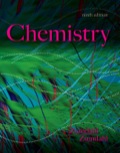
Concept explainers
A metal burns in air at 600°c under high pressure to form an oxide with formula MO2. This compound is 23.72% oxygen by mass. The distance between the centers of touching atoms in a cubic closest packed crystal of this metal is 269.0 pm. What is this metal? What is its density?
Interpretation:
The metal has to be identified and its density has to be calculated given its percentage mass and distance between the ionic centers of the compound of that element.
Concept introduction:
In packing of atoms in a crystal structure, the atoms are imagined as spheres. The two major types of close packing of the spheres in the crystal are – hexagonal close packing and cubic close packing. Cubic close packing structure has face-centered cubic (FCC) unit cell.
In face-centered cubic unit cell, each of the six corners is occupied by every single atom. Each face of the cube is occupied by one atom.
Each atom in the corner is shared by eight unit cells and each atom in the face is shared by two unit cells. Thus the number of atoms per unit cell in FCC unit cell is,
In FCC unit cell the atoms are assumed to touch along the face diagonal of the cube, so the face diagonal
‘
Answer to Problem 148IP
- The metal is identified as Rhodium.
- The density of Rhodium is calculated as 12.4 g/cm3.
Explanation of Solution
Identify the element using given data.
Given data: The element burns in air and forms
Assume 100.00g
The obtained value of weight is consistent with the atomic weight of Rhodium.
The atomic weight of the metal is calculated using given data to identify the metal. Since the
Determine the volume of FCC unit cell.
The distance between ionic centers is given and the volume is calculated by determining the edge length of the unit cell.
Determine the mass of the FCC unit cell.
Each unit cell has 4 Rhodium atoms. Therefore,
Each unit cell contains 4 Rhodium atoms. Therefore four times the average mass of one Rhodium atom gives mass of a unit cell.
Determine the density of metal.
Mass and volume of the unit cell is calculated in the previous steps. By substituting the values in the formula
The metal is identified as Rhodium and its density is calculated
Want to see more full solutions like this?
Chapter 10 Solutions
EBK CHEMISTRY
- For the condensation reaction between Alamine and histamine, please help me write the amididation reaction mechanism. Then write the three letter code for the product of the reaction, then write the one letter code for the product of the reaction. arrow_forwardHow to draw the reaction mechasnism belowarrow_forwardName the following molecules with IUpacarrow_forward
- What is the molecular orbital for cyclopropenyl anion and is it aromatic, antiaromatic or nonaromatic?arrow_forwardUsing the chart describe the change from cystine to tyrosine and its impact on the protein. Using the chart describe the change from histidine to aspartic acid and its impact on the protein.arrow_forwardHow to get the predicted product of this reaction belowarrow_forward
- Please help me fill out the chart then using the chart describe the change from cystine to tyrosine and its impact on the protein. Then using the chart describe the change from histidine to aspartic acid.arrow_forwardWrite the Esterification reaction mechanism for acetic acid, and one propanol to make propanol ethanoate (molecule that gives peas its odor in flavor)arrow_forwardProvide solutionsarrow_forward
- Which of these compounds is Ester formed from the reaction of acetic acid and one propanol arrow_forwardDescribe the four labeled parts of the reaction diagram from the reaction of sucrose, breaking down with and without an enzyme.arrow_forwardHow to determine the product with mechanism showedarrow_forward
 ChemistryChemistryISBN:9781305957404Author:Steven S. Zumdahl, Susan A. Zumdahl, Donald J. DeCostePublisher:Cengage Learning
ChemistryChemistryISBN:9781305957404Author:Steven S. Zumdahl, Susan A. Zumdahl, Donald J. DeCostePublisher:Cengage Learning Chemistry: An Atoms First ApproachChemistryISBN:9781305079243Author:Steven S. Zumdahl, Susan A. ZumdahlPublisher:Cengage Learning
Chemistry: An Atoms First ApproachChemistryISBN:9781305079243Author:Steven S. Zumdahl, Susan A. ZumdahlPublisher:Cengage Learning
 Chemistry: Principles and PracticeChemistryISBN:9780534420123Author:Daniel L. Reger, Scott R. Goode, David W. Ball, Edward MercerPublisher:Cengage Learning
Chemistry: Principles and PracticeChemistryISBN:9780534420123Author:Daniel L. Reger, Scott R. Goode, David W. Ball, Edward MercerPublisher:Cengage Learning Chemistry & Chemical ReactivityChemistryISBN:9781337399074Author:John C. Kotz, Paul M. Treichel, John Townsend, David TreichelPublisher:Cengage Learning
Chemistry & Chemical ReactivityChemistryISBN:9781337399074Author:John C. Kotz, Paul M. Treichel, John Townsend, David TreichelPublisher:Cengage Learning Principles of Modern ChemistryChemistryISBN:9781305079113Author:David W. Oxtoby, H. Pat Gillis, Laurie J. ButlerPublisher:Cengage Learning
Principles of Modern ChemistryChemistryISBN:9781305079113Author:David W. Oxtoby, H. Pat Gillis, Laurie J. ButlerPublisher:Cengage Learning





